- LA SOBREMESA
- Posts
- La Sobremesa #1: What to call a paella?
La Sobremesa #1: What to call a paella?
Most of paella recipes made by foreigners on the internet are completely wrong. Let's fix that.
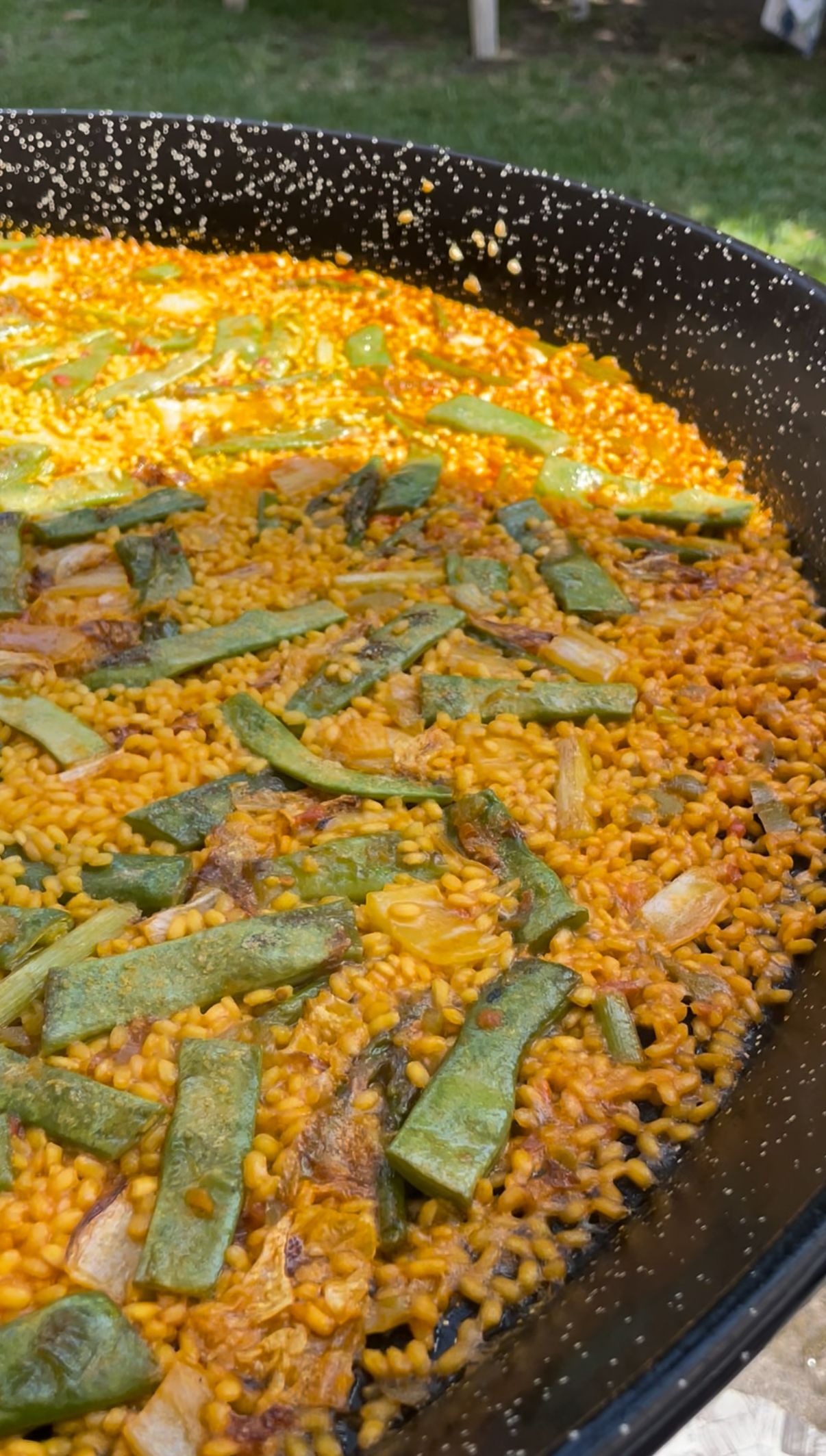
If you follow my channel, you probably already know that most paella recipes on the internet — not made by Spaniards — are completely wrong. And if you didn’t know that, well… now you do.
It’s a mess. Essential techniques are misunderstood or misapplied so often that many Spaniards find it downright disrespectful. And people even take it personally, like football hooligans defending their home team.
Now, I’m not a fan of this “food hooligan” mindset — the idea that food can’t evolve or be interpreted. That’s not how gastronomy works. If we were all food hooligans, only embracing tradition, gastronomy would look extremely stupid nowadays.
That said, I need to admit I do feel a little bit shocked when I see some foreigners’ attempts on paella. So let’s clear the air. I’m going to try my best in this article to solve most of the doubts on what to call, and not to call, a paella (if you care about not offending half of Spain).
What Does “Paella” Even Mean?
First, some definitions:
The word "paella" actually also refers to the pan — the wide, flat, shallow one.
This pan is used all over Spain, for plenty of recipes. Most of the time, rice dishes, but not always.
In Valencia, the rice and paella culture is particularly huge. They have their own traditional recipe:
Traditional Paella Valenciana includes:
🫒 Olive oil
🍗 Chicken
🐇 Rabbit
🫘 Local green beans and garrofó (lima beans)
🍅 Tomato
🌶 Smoked paprika
💧 Water
🌿 Rosemary
✨ Saffron
🧂 Salt
And that's it. Sometimes, seasonality includes other toppings like artichokes or snails.
This version even has Protected Designation of Origin status — meaning you technically could be sued for calling something “Paella Valenciana” if you mess with the ingredients 😳
So… Where’s the Controversy?
Valencians say the term paella should only refer to their dish. Everything else should be called ‘‘Arroz de…’’:
Arroz de marisco (seafood rice)
Arroz negro (black rice with cuttlefish)
Arroz de pato (duck rice)
…you get the idea.
They say it’s basically about protecting tradition and avoiding confusion.
But elsewhere in Spain, most people are a little looser with the term. We use paella to describe any dry rice dish cooked in a paella pan, as long as it follows certain rules:
Yellow-orange rice, thanks to saffron, paprika, or colorant.
Dry texture, from the extremely difficult technique of cooking it with the right amount of water (and fire) to nail the texture without ‘’liquid excesses'’.
Rice-to-topping balance — rice should always be the main character.
Ideally, some socarrat — the toasted crust at the bottom. I say ‘‘ideally’’ because I believe we all want that in our paellas, but sometimes you just don’t get it right. It’s a difficult technique that requires collagen in your stock, and lots of practice to not burn it.
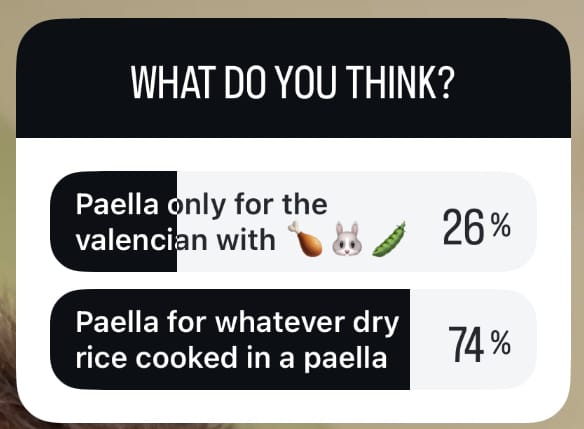
Here’s the poll I posted on Stories. Basically… 26% of my spanish followers are from Valencia 😂🫡
What Not to Do
Now, besides this internal war we still have in Spain on what to call or not a paella, there are some rules I believe we would all locals agree. Please, don’t call it paella if:
1. You can’t see the rice.
This is the most common mistake on paella recipes on the internet. If your overhead photo is just a bunch of toppings and no visible rice, that’s a fail. Balance is everything, and the best part of paella HAS TO BE the rice, which is supposed to be packed with flavour due to the next topic.

If your ratio rice-toppings doesn’t look like this… It’s wrong.
2. You use the wrong rice.
You must use short-rounded grain rice like bomba or senia, which absorb a good amount of liquid without breaking. Paella rice is supposed to be packed with flavor, and for that, it needs to suck a lot of flavory broth.
🛑 No long-grain. No basmati. Ever.
3. You add chorizo (without criteria).
I know. “Spanish = chorizo” is a thing on ‘‘spanish’’ recipes on the internet. And I get it. Most of times it’s kinda ok... But not with paella. Original paella recipes in Spain never includes chorizo. It's like the pineapple on pizza of spanish cuisine. Everybody does it outside of Spain, but almost no one inside. It would be a different situation if someone designs a ‘‘chorizo paella’’ or so, and proposes a logical way of including this ingredient on a spanish rice dish... But this is not the case most of times people use chorizo on paella, so… Just avoid it for now 😂
4. It’s too thick.
The layer of rice should be thin — ideally 2 cm, never more than 4. If the rice is too deep, the bottom grains overcook before the top ones are done. It literally doesn’t work.
What makes paella special is a well-developed and nuanced technique — and at least these four conditions must be respected. If they’re not, you’re not making even something similar to a paella. It may sound food hooligan vibe, but it’s just true.
🧠 Final Thoughts
I respect the Valencian purists, and I get why they’re protective. But I also understand the rest of Spain — and most of the world — just wants a name for this delicious, dry, golden rice.
So here’s my take:
If it’s a dry rice dish cooked in a paella pan, made with proper technique and balance, I call it paella.
And honestly? Most Spaniards I know do too.
But if this article helps even one person get closer to the real deal — with better technique, better rice, and more respect for tradition — then I think even the Valencians would be proud.
Recipes of the week 📝
Guille’s Gazpacho and Salmorejo
One of the things that makes me happier when the warm weather arrives is to have a big a$$ jar of cold gazpacho in the fridge. It’s refreshing, super healthy and can’t be easier to make.
There are probably as many recipes as spanish grandmas, so of course feel free to improvise and innovate. Some people add red pepper, onion, even carrot for the colour… In my opinion, none of those three ingredients add value to the matrix.
And hey, if food purists ask, i didn’t say this. But I’ve tried blending a couple of pickled jalapeños, lime and coriander into my gazpacho and holy f**!, you may want to try that.
On Sunday, we posted on YouTube a video comparing this recipe and salmorejo, another cold soup that deserves to be mention as a nice summer deal. You can check the video here.
GAZPACHO A cold watery vegetable soup, with tomato as the main ingredient, designed more as a refreshing drink than a starter.
No secrets. Just blend everything together until smooth and I recommend to not strain it to get the full nutritional value of the dish. | SALMOREJO A smooth emulsion of tomato and oil, thickened with bread. Served normally with hard boiled egg and jamón.
Blend the tomatoes bread, garlic and salt first, and add the oil little by little to get a velvety texture. |
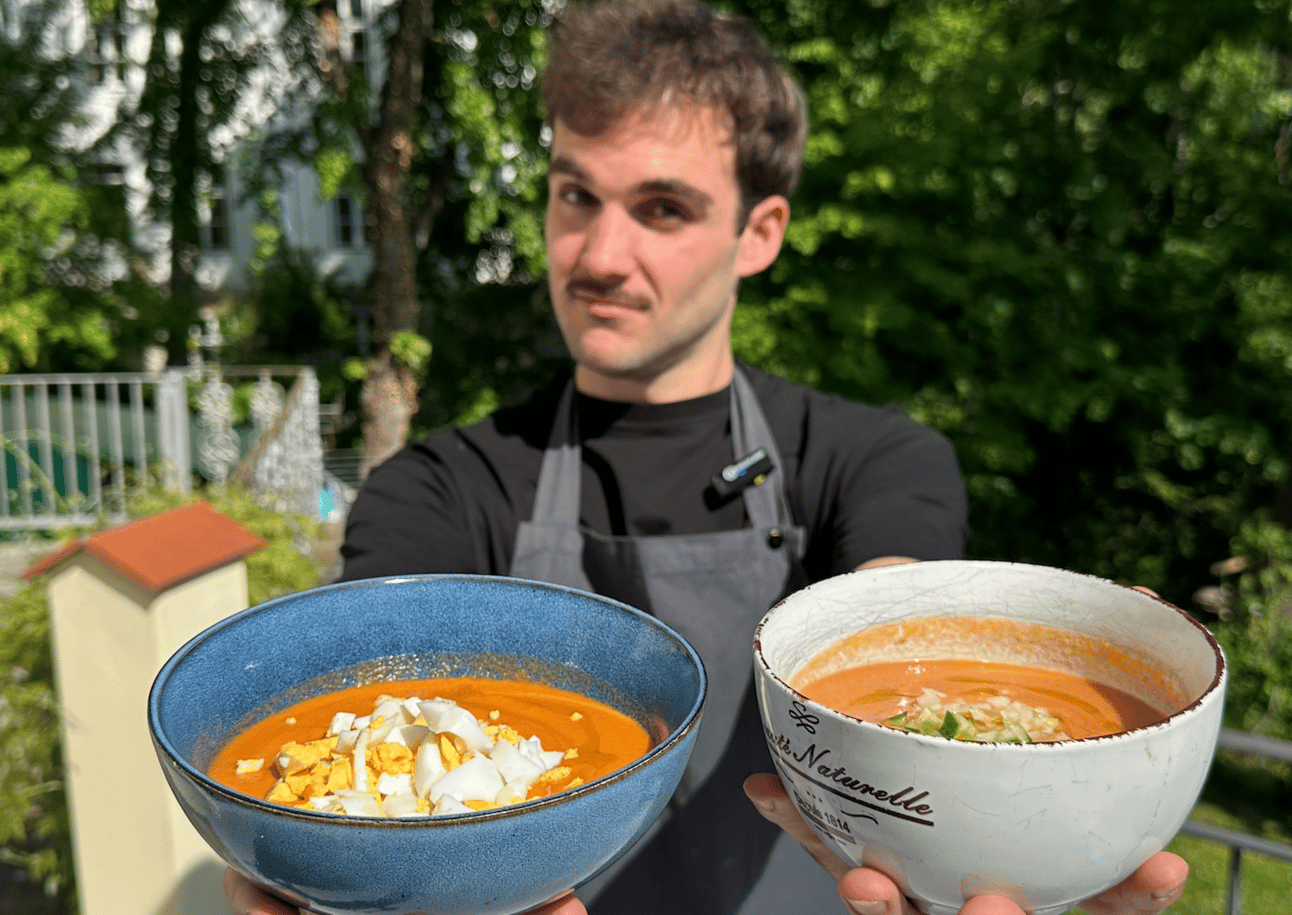
Gambas al ajillo
One of the most famous spanish tapas was posted last week on my account, after lots of people asked for it. It’s again a super simple recipe, but requires good product. Some haters may dislike the amount of oil that this dish includes… But honestly, that’s the best part soaked in bread. If you don’t like the idea, remove the oil and use it for other applications, as the perfect infused oil to twist anything. Here’s the recipe for around 4 people.
400 g of prawns. If you are using frozen ones, defrost and dry them with kitchen paper before using.
250 g of extra virgin olive oil
25 g of sliced garlic
2 bird eye cayennes (or to taste)
1 pinch of chopped parsley
Salt to taste
A good amount of bread to soak in the oil (if you are not on a diet 🤓)
Start by infusing the oil with the garlic and de cayenne at medium heat. Once it starts getting golden, but before browning, raise the heat and drop the prawns. Cook for no longer than 5 minutes (in my opinion, 3 is more than enough), and add the parsley right before serving. And thats it! It’s indeed extremely easy.
Some people add a tbsp of smoked paprika at the end, and/or a splash of a good sherry wine with the prawns. Both are variations that are worth the try if you feel creative some day.
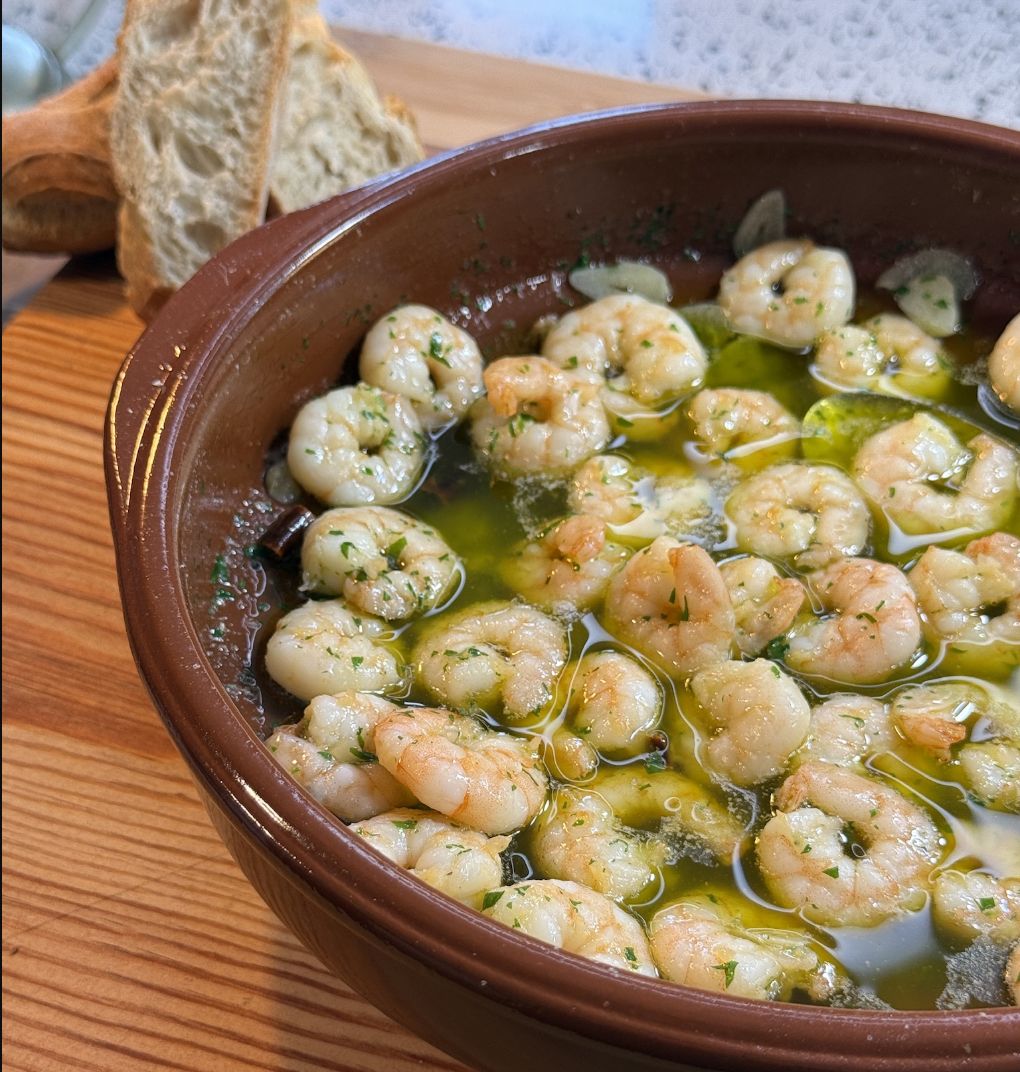
PATATAS THE SPANISH WAY #5: Patatas en ajopollo
I honestly think this series is gonna haunt me until my retirement. Every time I check, I find couple more recipes that deserve a spot in here. Spanish post war was long, hard and full of potatoes, I guess 🥵😂
This recipe comes from one of my fav regions of Spain so far, Andalucía, where art is present everywhere you go, in many forms, but especially in music, dance and food. And, even though the joy of stewing/cooking potatoes on different rich sauces or broths may be from the post war, this ‘’ajopollo’’ seasoning sounds way older. Grounding almonds, garlic, bread, parsley and saffron together to make a thickener paste is a spanish technique older than the ‘‘discovery’’ of America, as you could probably have guessed checking the ingredients.
Here’s the recipe for around 4 servings:
4-5 potatoes (650 g)
2 onions (200 g)
2-3 garlic cloves (15 g)
60 g of almonds
40 g of stale bread
3-4 parsley stems and leaves
1 bay leaf
1 tbsp of smoked paprika
Cayenne pepper to taste
Salt and pepper to taste
Olive oil
Chicken broth to cover (or any of your choice)
1 egg per person to poach in the stew
Start by making the ‘‘majado’’ by frying in olive oil the almonds, garlic, bread and parsley. Bring everything to a jar and blend with some chicken broth. Traditionally, you would use a pestle and mortar, but the result is finer with a blender.
With the same oil, stir fry the onions with the cayenne. Meanwhile, peel and crack the potatoes as seen in the video. This helps release the starch and will thicken the sauce later. Add them to the pot and stir fry for couple minutes, right before adding the smoked paprika. Stir fry for one more minute, but be careful not to burn the paprika!
Drop the majado, cover with chicken broth and cook this for 45 minutes to one hour, depending on the potatoes. Just make sure you slow cook them until soft and the sauce thickens.
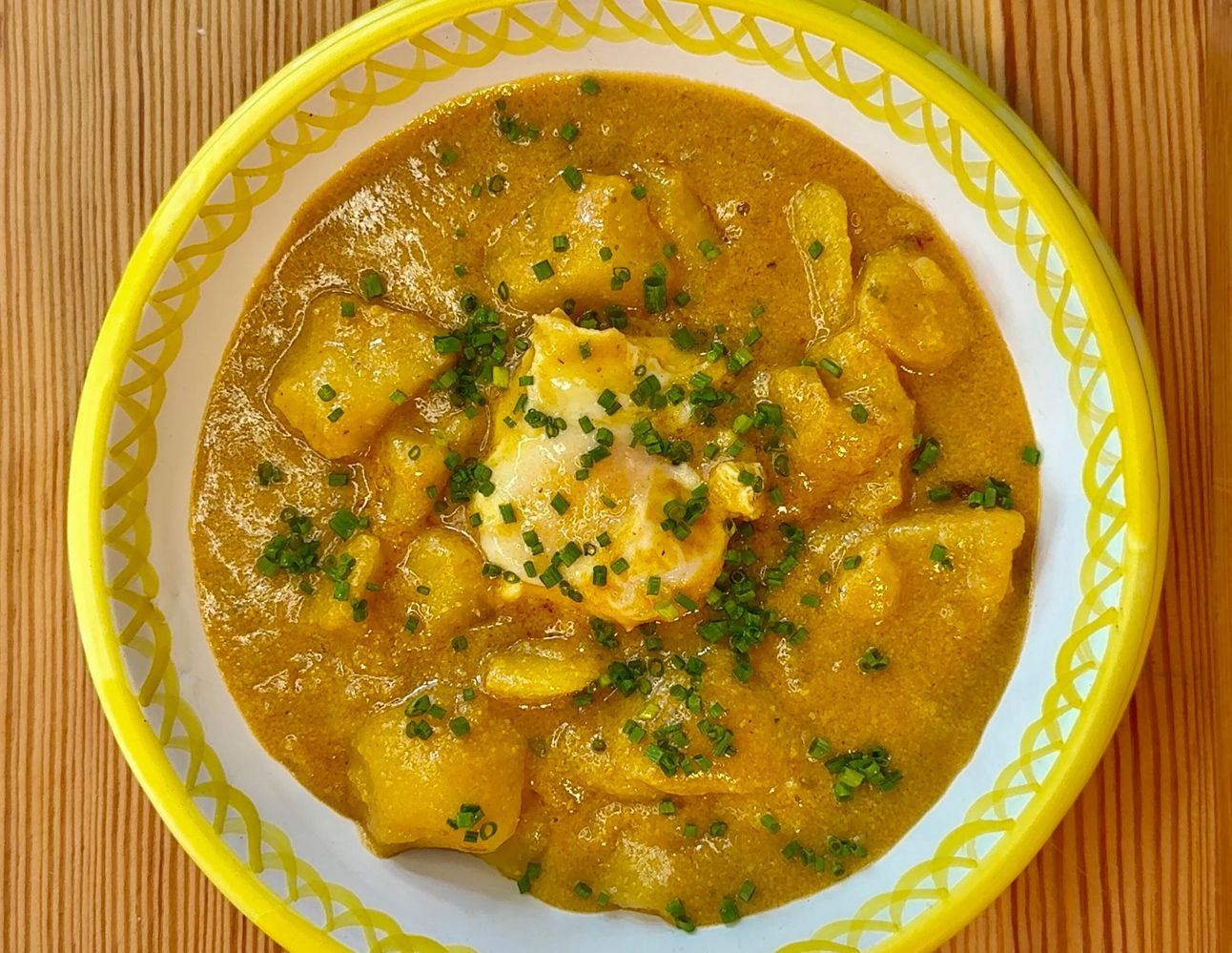
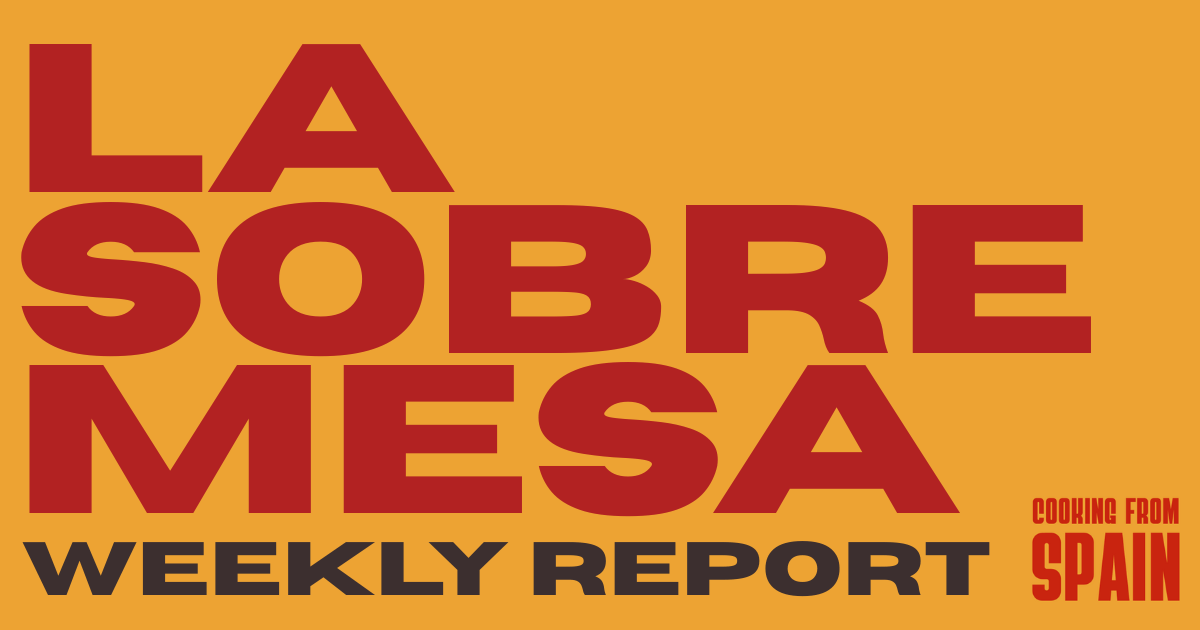
Reply